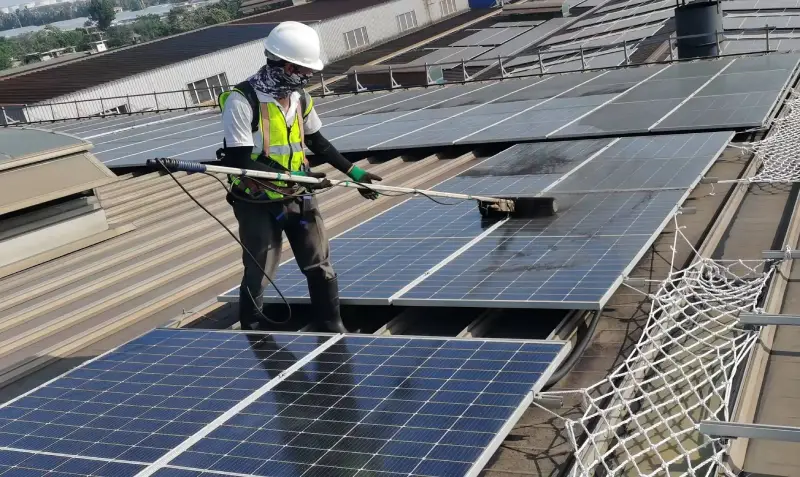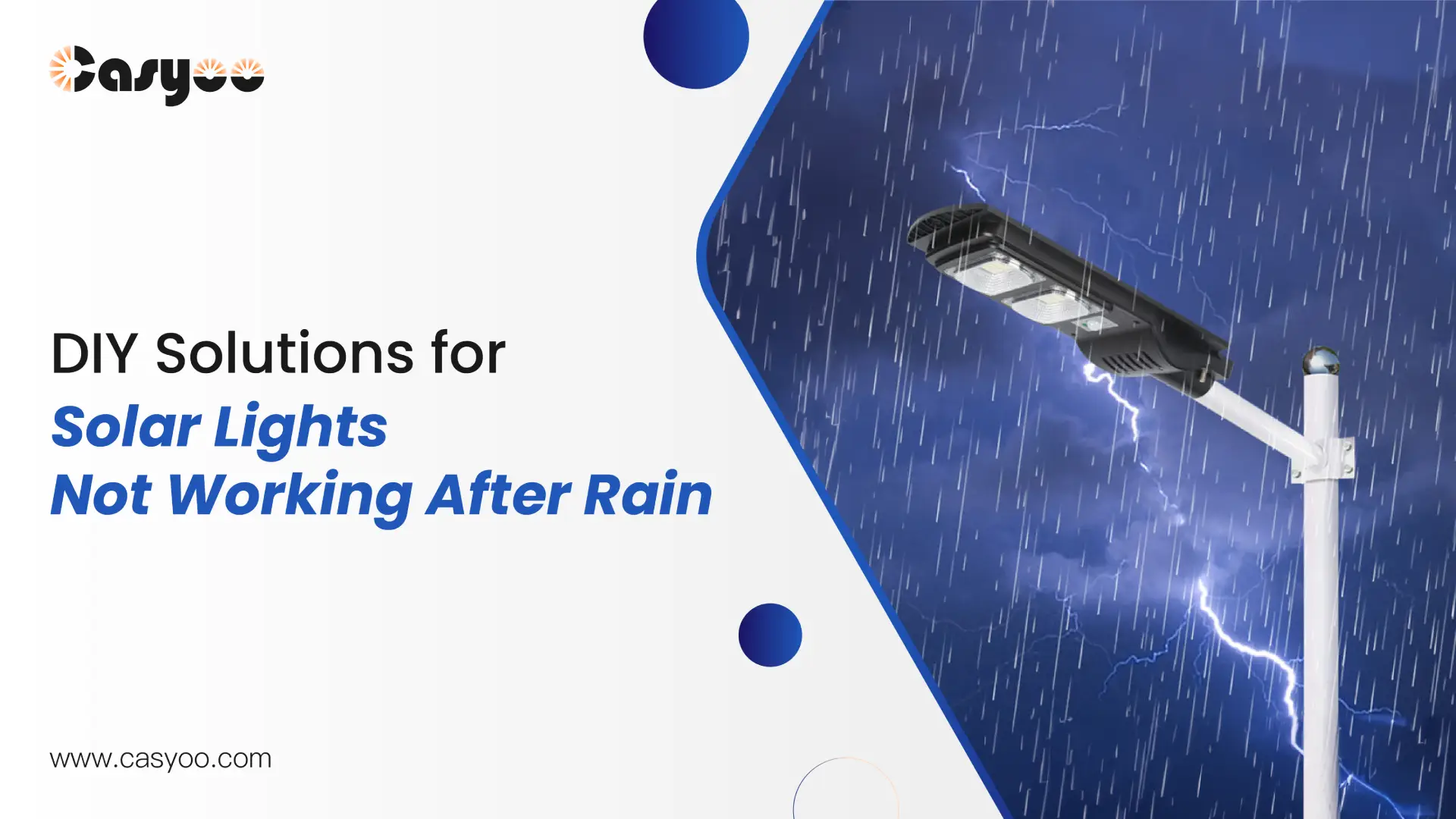Imagine this: a rainy evening, your garden looks magical with solar lights casting a soft glow. But the next day, they stop working. Frustrating, isn’t it? This is a very common problem that arises for many homeowners and DIY enthusiasts who use solar-powered lighting. The good news is, rain alone doesn’t destroy solar lights. Instead, underlying problems such as water ingress, insufficient sunlight, or even dirty panels are often the culprits. In this article, we’ll explore the most common reasons for solar lights not working after rain and, more importantly, provide practical solutions to restore their functionality.
If you want maintenance guidelines that are easy to do or troubleshooting steps to save on repair costs, then do read-more to become your own solar light technician.
5 Causes and Solutions for Solar Lights Not Working After Rain
1. Water Ingress
One common reason why some solar lights refuse to function after rain is water ingress. Water may infiltrate the circuits or even the batteries of a poorly sealed light during heavy downpours. This problem usually arises due to poor manufacture and also through wear and tear.
Solution:
Inspect the housing for cracks and gaps to prevent water intrusion. Carefully open the light, and with a soft cloth, dry its internal parts. Make sure no signs of moisture remain. Add extra protection with a waterproof sealant to reinforce the seals. In extreme cases of damage, the seals may need to be replaced.
To avoid further problems, use solar lights with an IP65 or higher waterproof rating. These are rated to withstand heavy rain without degrading performance.
2. Insufficient Sunlight
Solar lights charge the battery using sunlight. Rainy or overcast days reduce the charging efficiency considerably. It is estimated that clouds block 10–25% of sunlight, making the battery insufficiently charged. This is worse because if the lights are installed in shaded areas, the problem gets worse.
Solution:
Position your solar lights to get the most sunlight exposure. Avoid shaded areas under trees, walls, or buildings. Angle the solar panel seasonally to maximize sunlight exposure.
For areas with long rainy seasons, consider upgrading to lights with larger solar panels or dual charging capabilities (solar and USB) to ensure consistent performance.
3. Dirty Solar Panels
It does not clean your solar panels but brings dirt, dust, or residues that prevent absorption of sunlight; in the long term, it weakens the efficiency of the panel and reduces the charging period of the battery.
Solution:
Cleaning your solar panels is easy but necessary. Use a damp cloth with mild soap to wipe the panels clean, avoiding abrasive materials that might scratch the surface. Try to clean the panels every three to six months, or more often in dusty environments.
Think of it as giving your lights a breath of fresh air—they’ll thank you with brighter and longer-lasting illumination.

4. Battery Issues
Batteries are the heart of solar lights, and like any battery, they degrade over time. A typical solar light battery lasts 1–2 years, but exposure to water or poor maintenance can shorten its lifespan significantly.
Solution:
Open the light housing and check the battery for any corrosion, leakage, or wear. Replace old batteries with high-quality rechargeable NiMH or lithium-ion, which will last for 3–5 years properly cared for.
For new lights just installed, ensure that the protective pull tab has been removed from the battery—this little oversight can keep the light from charging at all.
5. Sensor Malfunctions
Solar lights feature sensors that turn them on when there is light or movement. Rain and dirt can cause these sensors to malfunction or fail to turn the lights on.
Solution:
Check the sensor by covering it with a dark cloth to simulate night. The sensor may be malfunctioning or unclean if the light does not turn on. To remove dirt or water residue from the sensor, gently clean it with a soft cloth.
If cleaning is not effective in solving the issue, it’s time to change the sensor. Call the manufacturer to ask if they have available replacement parts, or consider purchasing a model with sturdier sensors.
Preventative Measures to Protect Solar Lights from Rain
Improving Waterproofing
Prevention is better than cure. Most solar lights are made waterproof, but the continuous wear and tear, or low quality of materials, may eventually reduce their waterproof properties.
Start by checking your lights for cracks or gaps in the housing, particularly around the solar panel and battery compartment. Use waterproof sealant on any weak points. In areas that experience high rainfall, it is advisable to purchase protective covers or shields to reduce direct water exposure.
When purchasing solar-powered lights, try to find models with at least an IP65 waterproof rating—meaning they can stand the rain from every angle, making them perfect for being placed outdoors.
Regular Maintenance
Maintaining your solar lights doesn’t have to be a big thing. Simple steps can go a long way toward improving their effectiveness and extending their life.
- Cleaning: Dust, dirt, and water residue can prevent sunlight from hitting the solar panel and decrease the charging efficiency up to 30%. Once every three to six months, clean the solar panels with a soft cloth and mild soap.
- Inspection: Look for loose or broken parts, especially after a strong storm. Secure the screws and replace the broken parts.
- Battery Replacement: Replace the batteries every 1-2 years, or when performance degrades dramatically.
Consider maintenance an investment—a minor effort that saves larger difficulties in the future.
Selecting Weather-Resistant Designs
Not all solar lights are created equal. Choose lights that are built to withstand your local climate for long periods of time.
- Tropical Regions: Use corrosion-resistant materials such as stainless steel or ABS plastic for withstanding humidity and frequent rains.
- Cold Climates: Use lithium-ion batteries. Since Li-ion batteries tend to perform well in freezing temperatures, they work better than NiMH batteries. Heated panels can also stop snow from forming.
- Dusty or Arid Areas: The dustproof designs should have an IP67 rating to prevent damage from internal dirt.
When to Consider Professional Help
While DIY repairs are rewarding, there are times when professional assistance is necessary.
If your solar lights have severe internal damage, such as burned-out circuits or irreparable water ingress, it’s safer and more effective to consult a technician. Similarly, if replacing parts like sensors or batteries doesn’t resolve the issue, the light may need expert evaluation.
Always prioritize your safety. If you’re not sure how to handle electrical components, you should leave the job to professionals.
Ready to Protect Your Garden Lights from Rain?
Is your outdoor lighting ready for the next heavy downpour? Don’t let water ingress or insufficient sunlight dim the beauty of your garden. With a little maintenance and the right design choices, you can enjoy reliable, year-round illumination rain or shine.
Looking for solar lights that are built to last? At Casyoo, we specialize in durable, weather-resistant LED solar lights tailored for all climates. Whether you’re facing tropical rains, freezing winters, or dusty summers, our lights are designed to perform.
Explore our range of LED solar lights here or contact us today to find the perfect lighting solution for your outdoor space. Illuminate your garden with confidence—no matter the weather!




